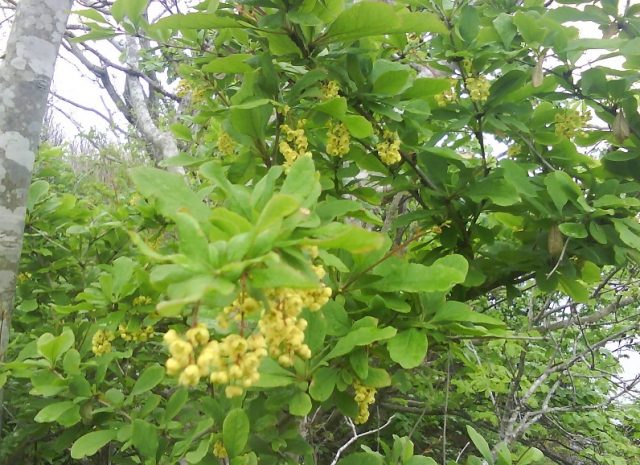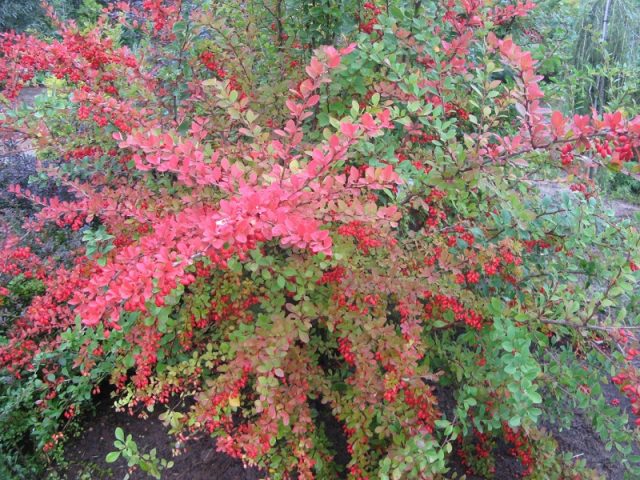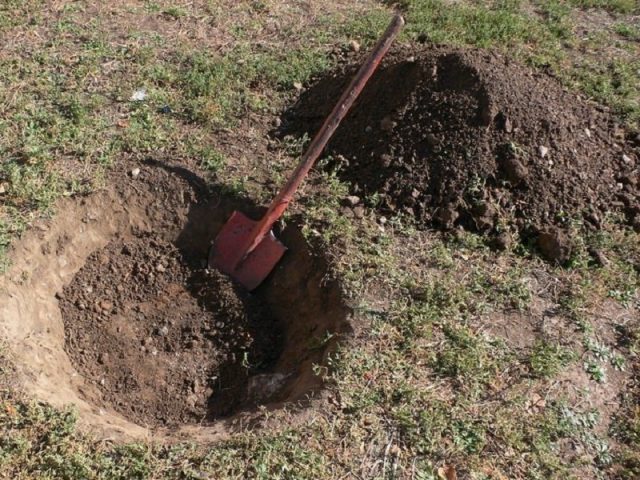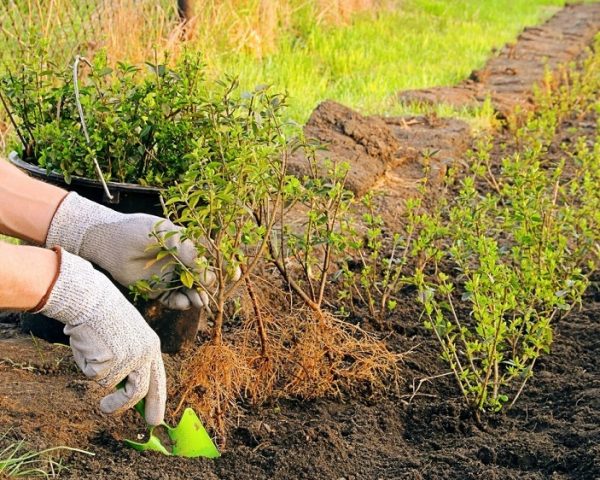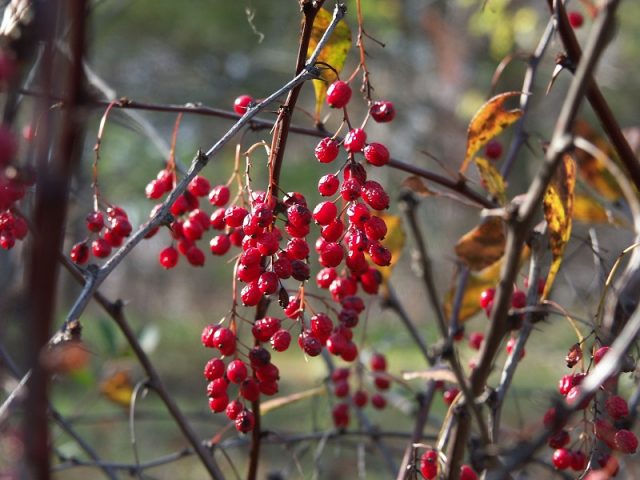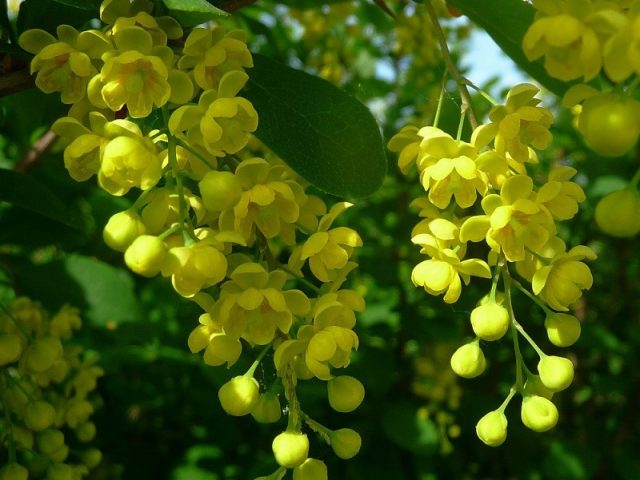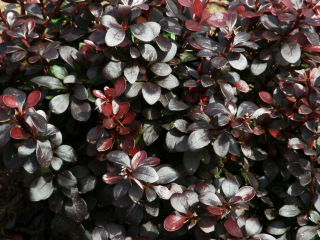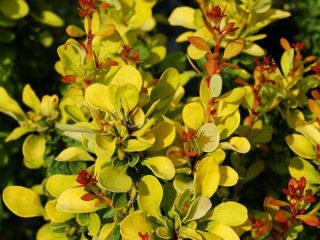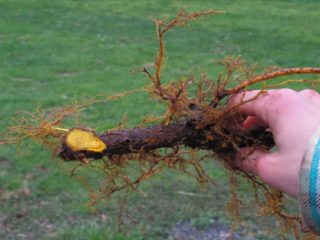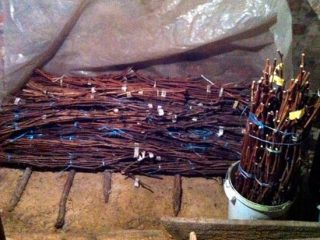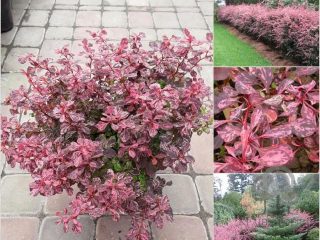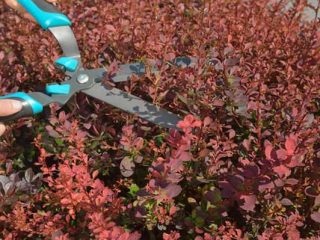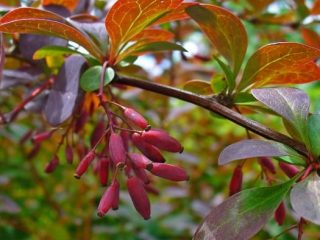Content
The leading position in the ranking of the popularity of ornamental shrubs is occupied by Amur barberry for its healthy fruits, high level of fruiting, good taste and ease of care. Every year the number of fans of this luxurious and healing plant is rapidly increasing. The crop is grown as a supplier of tasty berries, for aesthetic purposes, to create shaded corners and living fences.
Description of Barberry of Amur
Amur barberry is a deciduous thorny shrub of the Barberry family. The plant can reach a height of up to 2 meters. The shrub forms straight, weakly branched, erect and ribbed branches, painted yellow, which turn gray by autumn. The plant is decorated with obovate or elliptical leaves, arranged in bunches on shortened shoots. The length of the leaf plate is 12 cm and the width is 5 cm. The bright color of the leaves attracts attention: in summer they are light green, and in autumn they acquire a purple, dark red hue.
The plant has spines that are yellowish in color and up to 3 cm long.The inflorescences are racemose, up to 10 cm long, consisting of 10–25 drooping flowers, painted pale yellow and distinguished by a strong aroma. The berries of Barberry Amur are bright red, ellipsoidal in shape, 1 cm long. The fruits are dry and sour in taste. The photo of Barberry of Amur is truly mesmerizing to look at.
The plant pleases with its flowering for 3 weeks. The fruits ripen in August–October. Harvesting can be done in late autumn - in November.
Medicinal properties
The perennial thorny shrub Amur barberry owes its healing ability to its unique chemical composition, so products based on it can be used as an auxiliary treatment for many diseases to increase their effect. The benefits of the plant are determined by the fact that Amur barberry:
- belongs to the pharmacological group of anti-inflammatory and sedative herbal medicines;
- used as a bactericidal, hemostatic and antipyretic agent;
- has a choleretic and diuretic effect;
- helps increase appetite;
- used in cooking, since the sour-bitter taste of the fruit makes Amur barberry a universal seasoning for sauces, meat and fish dishes.
The roots, bark, leaves, flowers, and berries of the thorny shrub, Barberry Amur, are used as raw materials for treatment. Healing agents are prepared from them in the form of infusion, decoction, tea, oil, each of which is endowed with healing powers and has found application in the healing of various diseases.
Medicinal properties of the perennial shrub Barberry Amur:
- a decoction prepared from the bark and roots of the plant treats diseases of the respiratory system, tuberculosis, pneumonia, malaria;
- an infusion of crushed roots has a healing effect for rheumatism and arthritis;
- tincture based on Barberry of Amur is used in obstetric practice, in the postpartum period for bleeding and for endometritis at the time of menopause;
- decoctions help improve a person’s condition in cases of kidney dysfunction, bladder pathology, cystitis, urethritis;
- teas from the fruits of the plant are used as an antiscorbutic agent, as well as for cholelithiasis, impaired motor activity of the bile ducts, and hepatitis;
- substances found in the roots, bark and leaves of the perennial thorny shrub Amur barberry are considered effective helpers for pathologies of the cardiovascular system, and also lower blood pressure;
- for intestinal infections and digestive disorders, use tinctures or decoctions of Amur barberry, which promote the rapid restoration of microflora.
- is a component of creams intended to treat skin diseases, and oil extracts and infusions help cure eczema and frostbite.
Planting and caring for the Amur barberry bush
The favorable period for planting the perennial thorny shrub Barberry Amur is spring and autumn. Before planting, you need to find out where the plant grows and bears fruit well, as well as how to properly organize the care of the crop.
Preparing seedlings and planting area
High-quality planting material is a determining factor when planting Amur Barberry, since weak seedlings affected by pests and diseases will not grow into full-fledged, fertile bushes. Therefore, seedlings should be characterized by a strong and strong root system without obvious defects.
When choosing a place for planting, you need to take into account both the aesthetic appearance of the garden plot and the needs of the plant for its normal growth and development.
Amur barberry is very picky about location, heat and moisture. Therefore, preference should be given to spacious, sunny places, not shaded, but protected from drafts. Also, the perennial thorny shrub Amur barberry reacts poorly to the proximity of groundwater and stagnant moisture, so it is advisable to plant it on a slope. The crop does not suffer from a lack of organic matter in the soil, but if there is excessive acidity above pH 7.5, care should be taken to add limestone or dolomite flour.
Before planting the perennial thorny shrub Barberry of the Amur, it is important to prepare the hole in advance. For bushes no older than 3 years of age, the diameter of the planting hole should be 25 cm and the depth should be 25–30 cm. For seedlings aged from 4 to 7 years, you need to make a recess with a diameter and depth of 50 cm. If the crop is planted with the aim of creating a living hedges, you will need a trench 40 cm deep and wide.
After the planting hole is organized, a nutrient mixture is needed to fill it, which should contain humus, sand and loose garden soil in equal proportions.
Landing rules
Proper planting is a guarantee of the successful development and comfortable existence of the perennial thorny shrub Amur barberry, so you should adhere to the following procedure:
- Prepare the planting hole and lower the seedling so that the root neck is underground at a depth of 3 cm.
- When planting a hedge, you should maintain a distance between planting units, which should be 30–40 cm.
- Compact the soil around the bush and pour about one bucket of warm water into the tree trunk circle.
- Upon completion of the planting process, mulch the soil using sawdust or leaves.
Ornamental trees and shrubs of Amur Barberry, planted in a garden plot, will bring a lot of gifts: joy to the eyes, clean air to the lungs and bliss to the taste buds.
Watering and fertilizing
Watering should be done once a week. And at the time of shoot growth, ovary formation, and fruit ripening, Amur Barberry bushes may experience a need for moisture. To keep the soil moist, especially during the dry season, it is necessary to increase the amount of watering.
Amur barberry is responsive to good nutrition, which can be mineral and organic fertilizers. You can feed it in the second year after planting. After each application of fertilizer, the soil should be mulched with a mixture of peat and rotted manure. This will help the fertilizers to be better absorbed, and will also protect the perennial shrub Amur barberry from growing weed and retains moisture.
Trimming
Every year it is necessary to prune the Amur Barberry bush, removing weak and poorly developed shoots. In spring, it is recommended to thin out old bushes.When forming hedges, pruning should be done in the second year after planting, cutting off half of the ground part. In the future, prune twice a year: in June and August.
Preparing for winter
With the arrival of autumn, preparations for winter of all garden plants begin, including the perennial shrub Amur barberry. First you need to put things in order in the tree trunk circles:
- remove debris and dig up the soil under the bush;
- fertilize using humus or compost;
- carry out sanitary pruning;
- perform mulching using loose peat or dried leaves.
Young bushes of Amur Barberry under the age of 5 years are very sensitive to winter cold, so they must be covered with spruce branches before the first frosts. Large thorny bushes can be tied with a rope, a lattice box can be built around it, dry leaves can be poured into it, and agrofibre can be wrapped on top.
Reproduction
Amur barberry reproduces well by cuttings, layering and seeds. The best option for a novice gardener would be to buy a seedling, since propagation using seeds will take a lot of time.
To propagate a plant by cuttings, you need to carefully cut it, plant it in fertile soil, water it and wait until roots form. Then transfer it to a permanent place in open soil.
When propagating by layering, the shoot should be pinned to the ground and covered with damp soil. The soil needs to be moistened until the cuttings take root.Amur barberry can also be propagated by dividing the bush. This will not only provide planting material, but will also help rejuvenate the plant and maintain its intensive development. To do this, the bush must be carefully removed from the ground, divided and planted. In this case, the perennial thorny shrub Amur barberry will quickly take root and begin to bear fruit.
Diseases and pests
Amur barberry is susceptible to various diseases that affect the quality of the crop and the life expectancy of the plant. It is important to detect and identify the disease in a timely manner and take appropriate measures. The most common disease is powdery mildew, which manifests itself as a powdery coating on leaves, shoots and fruits.
For better protection against diseases of the Amur Barberry bush, the necessary procedures should be followed. Firstly, remove dead foliage, trim dried shoots, and secondly, systematically carry out preventive treatment with a solution of colloidal sulfur, a sulfur-lime mixture. And remember to feed the root system with nutrients.
The perennial thorny shrub Amur barberry can also be attacked by pests, namely barberry aphids and flower moths. To ensure that the plant does not become a center of insect accumulation, protective operations must be carried out. In spring and autumn, remove and burn fallen leaves. Regularly inspect the Amur Barberry and, if pests are detected, urgently begin to combat them, resorting to mechanical and chemical methods of getting rid of various insects.
Conclusion
Amur barberry has earned popularity due to its beautiful bush shape, large leaves, abundant flowering and fruiting.It is not for nothing that landscape designers have chosen this perennial thorny shrub to create hedges and borders in the garden.
